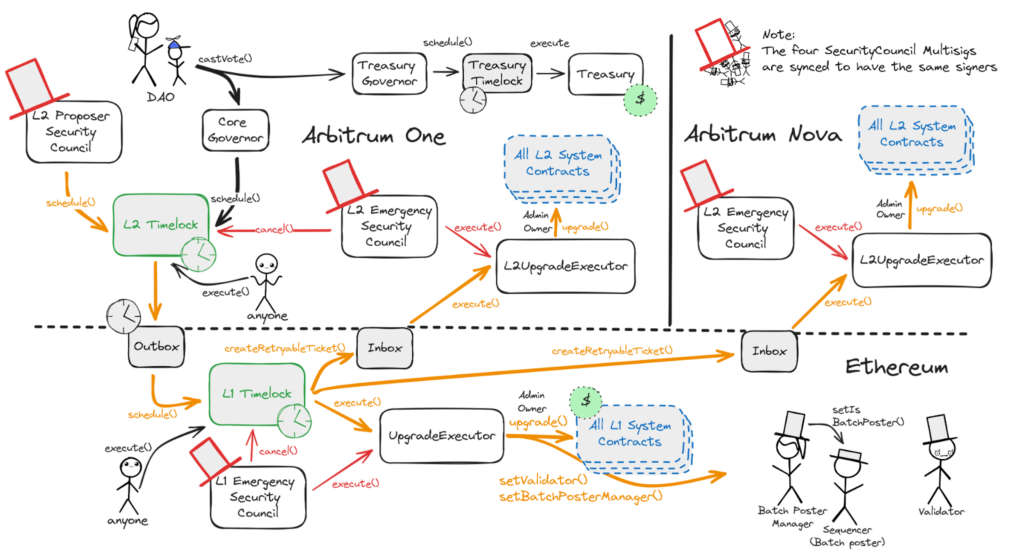Ethereum’s blockchain is like a busy city with gridlocked of traffic secure and accessible to all. But often bogged down by its own popularity.
- What Is Arbitrum One?
- What Is Arbitrum Nova?
- Arbitrum One vs. Arbitrum Nova – A Comparative Analysis
- Performance Metrics: Finding the Right Fit
- Use Case Scenarios
- Balancing Security and Decentralization
- The Road Ahead for Arbitrum One and Nova
- Conclusion
This is where the Layer 2 scaling solution Arbitrum promises to clear the congestion. Doing so by offering faster and cheaper transactions.
Within the Arbitrum ecosystem, Arbitrum One and Arbitrum Nova stand out as two distinct pathways. Each designed to address different needs.
When talking about Arbitrum One versus Arbitrum Nova, these are two Layer 2 solutions designed to build up Ethereum’s scalability and efficiency. Arbitrum One utilizes an Optimistic Rollup protocol which makes it ideal for applications that prioritize security and decentralization. In contrast, Arbitrum Nova makes use of the AnyTrust protocol and offers high throughput and cost efficiency.
But which one is right for your project?
In this guide, we’ll walk through the key differences and use cases of Arbitrum One vs. Arbitrum Nova.
What Is Arbitrum One?

Arbitrum One is the flagship offering in the Arbitrum ecosystem which is designed to supercharge Ethereum’s scalability without compromising its core values. Think of it as the heavy-duty machinery that does the lifting when Ethereum gets too crowded.
Arbitrum One uses an Optimistic Rollup mechanism to execute transactions off-chain which is powered by the Nitro technology stack. It does so, while posting only the essential data back on Ethereum’s mainnet.
The consequence, you ask? A notable reduction in gas fees and faster transaction processing. Thus, making it a go-to solution for developers scaling their decentralized applications (dApps).
Built for Efficiency: Arbitrum One’s Architecture
Arbitrum One’s architecture is a blend of innovation and compatibility. The Optimistic Rollup protocol assumes that transactions are valid unless challenged. This minimizes on-chain computation and keeps things running smoothly. This process bundles multiple transactions into batches and reduces the strain on Ethereum’s Layer 1 (L1).
What really sets Arbitrum One apart is the Nitro stack, which introduces a “Geth-at-the-core” architecture. This upgrade allows Arbitrum One to support Ethereum’s native Solidity contracts, making it seamlessly compatible with the Ethereum ecosystem.
Additionally, Nitro optimizes the execution environment by integrating WebAssembly (WASM). Ensuring that smart contracts run smoothly and affordably.
How Does the Arbitrum Rollup Work?
At the heart of Arbitrum One’s scaling prowess is its rollup process.
Let me draw you up a picture of this!
So basically, several transactions are bundled into a single batch which is then posted to Ethereum’s L1. This batch contains all the necessary components to reconstruct off-chain transaction states, compressed to save on gas fees.
Meanwhile, the Rollup contract on Ethereum keeps a watchful eye to ensure that everything lines up with the on-chain ledger.
Transaction Dissection via the Arbitrum Virtual Machine (AVM)
The Arbitrum Virtual Machine (AVM) plays a crucial role in streamlining off-chain computation. The AVM ensures that validators can process them efficiently by breaking down complex transactions into smaller more manageable pieces. If a dispute arises, the AVM’s architecture allows for quick identification and resolution of the issue. Thus, further reducing gas costs and boosting transaction throughput.
Arbitrum One in the Real World
Arbitrum One isn’t just theoretical, it has been battle-tested in the real world and the results are impressive.
Developers have flocked to Arbitrum One to build scalable dApps, particularly in the interests of building –
- Decentralized finance (DeFi),
- Decentralized exchanges (DEXs)
- NFT marketplaces.
For instance, Uniswap is one of the leading DEXs and has deployed its smart contracts on Arbitrum One. The platform now offers users faster transactions and lower fees which is a win-win for both developers and users. Isn’t that amazing?
What Is Arbitrum Nova?
While Arbitrum One is the workhorse, Arbitrum Nova is the sprinter which is built for speed and efficiency. Launched as a high-performance alternative, Arbitrum Nova uses the AnyTrust protocol which is a variant of Nitro. Using Anytrust protocol , it delivers ultra-low transaction costs while maintaining a balance between security and performance.
Unlike Arbitrum One, Nova basically introduces a Data Availability Committee (DAC) to handle transaction data off-chain. Hence, making it perfect for applications that require to process a large quantity of low-cost transactions such as gaming and social media.
Optimized for Speed: Arbitrum Nova’s Architecture
Arbitrum Nova’s architecture is all about efficiency. The AnyTrust protocol relies on a DAC composed of trusted validators to ensure data availability off-chain. Let me tell you that the approach reduces the need to post large amounts of data on Ethereum’s L1, resulting in more efficient transaction processing.
Like Arbitrum One, Nova is powered by the Nitro stack and it also benefits from WASM-based execution and Ethereum compatibility. However, the key difference lies in the trust assumptions.
While Arbitrum One sticks closely to the decentralization ethos, Nova makes a calculated trade-off and introduces a trust layer to achieve lower transaction costs and higher throughput.
Data Availability Committee (DAC)
The DAC is the secret sauce behind Arbitrum Nova’s efficiency.
Nova reduces the need for on-chain data postingBy offloading data storage to a trusted committee. This in turn slashes transaction costs. While this introduces a slight centralization the trade-off benefit is a faster and more cost-effective platform that’s ideal for high-throughput applications.
Optimized for High-Throughput Applications
Nova’s architecture is particularly suited for applications where speed and cost are critical. For example, gaming platforms, social networks and microtransactions areas where A large quantity of low-cost interactions are a must.
Nova’s ability to handle large volumes of transactions quickly and affordably has made it a popular choice for these kinds of applications.
Arbitrum Nova in Real-World
Arbitrum Nova shines in scenarios where transaction volume and cost efficiency are of the most importance
Gaming platforms have especially benefited from Nova’s architecture, which allows for the rapid processing of microtransactions. Similarly, social media platforms that rely on constant user interaction can use Nova to enhance the user experience while keeping operational costs low.
Now let’s talk about the comparison in detail, shall we?
Arbitrum One vs. Arbitrum Nova – A Comparative Analysis
Now, we will talk about the specifics of Arbitrum One vs. Arbitrum Nova and the key differences in performance metrics and use cases become evident.
Performance Metrics: Finding the Right Fit
When it comes to performance, Arbitrum One and Arbitrum Nova serve different niches. Arbitrum One, with its Optimistic Rollup protocol, processes around 20 transactions per second (TPS) while maintaining high security and decentralization.
While, Arbitrum Nova handles about 6.4 TPS, but at a fraction of the cost, making it a more economical choice for applications that don’t require full decentralization.
Arbitrum One’s rollup mechanism is perfect for applications where security is a top priority, such as financial platforms and DEXs. On the other hand, Nova’s AnyTrust protocol introduces some centralization but offers major cost savings. Making it ideal for gaming, social media, and other high-throughput applications.
Use Case Scenarios
Choosing between Arbitrum One and Arbitrum Nova comes down to understanding your project’s needs. If your application demands ironclad security and decentralization, Arbitrum One is the way to go. Its powerful architecture ensures that every transaction is secure makes it the preferred choice for financial applications and DEXs.
However, if your primary concern is throughput and cost efficiency, Arbitrum Nova is your best bet. Its architecture is optimized for handling large volumes of transactions quickly and affordably.
For example, a gaming platform that needs to process thousands of microtransactions per second would benefit more from Arbitrum Nova due to its cost efficiency. Conversely, a DEX that prioritizes security would find Arbitrum One more suitable.
Balancing Security and Decentralization
Security and decentralization are the bedrock of blockchain technology and Arbitrum One and Nova take different approaches to these concepts. Arbitrum One leans heavily on Ethereum’s L1 for security. The solutions job is to make sure that all transactions are as secure and decentralized as possible.
Arbitrum Nova on the other hand, introduces a balance between security and performance. Nova can process transactions faster and cheaper By relying on the DAC. But with a slight compromise on decentralization. This trade-off makes it a good fit for applications where speed and cost matter more than absolute trustlessness.
The Road Ahead for Arbitrum One and Nova
Looking ahead the Arbitrum’s roadmap includes exciting developments for both One and Nova. The introduction of tools like Arbitrum Orbit allows developers to create custom Layer 2 and Layer 3 chains using the Nitro stack. These innovations are expected to further enhance the performance, security and developer experience across both platforms.

Talking about the challenges, Arbitrum will need to bring a delicate balance between decentralization and scalability. Even though the introduction of the AnyTrust protocol in Nova while beneficial for performance it still raises questions about centralization.
With the ongoing development of trust-minimized solutions and strong security measures, Arbitrum is well-positioned to maintain its leadership in the Layer 2 space.
Conclusion
In the battle of Arbitrum One vs. Arbitrum Nova, there’s no one-size-fits-all answer. Each platform has its strengths and trade-offs. The right choice depends on the specific application of it.
Arbitrum One is the clear choice for projects that prioritize security and decentralization, making it ideal for financial applications and DEXs. On the other hand, Arbitrum Nova excels in scenarios where cost efficiency and high throughput are key for applications such as gaming and social media platforms.
Ultimately, understanding these key differences and aligning them with your project’s goals will empower you to make the best choice.


















